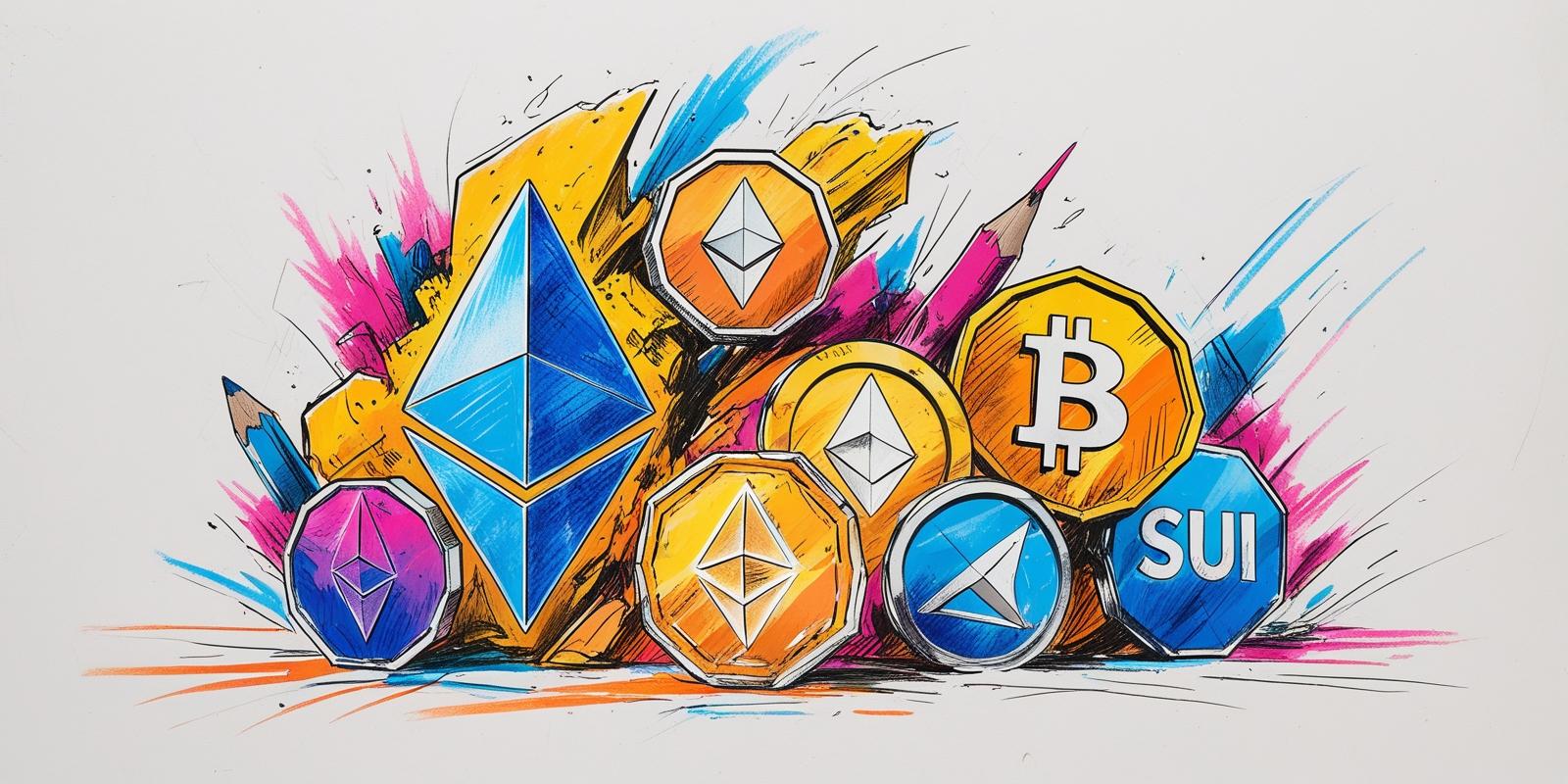Can Ethereum Compete with New Blockchains?
By
Kamlesh Patyal
July 21, 2025
Ethereum, launched in 2015, brought programmable money and decentralized applications into the mainstream. Its reputation as the most secure and battle-tested smart contract blockchain helped it attract billions in liquidity and millions of active wallets. However, today’s landscape is more competitive than ever. Dozens of new Layer 1 blockchains have emerged, each promising lower fees, faster transactions, and easier scaling. Platforms like Solana, Avalanche, Polkadot, Cosmos, Near, Aptos, and Sui all seek to claim market share from Ethereum by solving its well-known challenges.
This raises an important question for developers and projects: Can Ethereum maintain its lead and remain competitive against these new blockchains? Join ChicMic Studios and let’s examine this question through the lens of technical strengths, network effects, security, and future scaling can provide some clarity.
Why Ethereum Became the Smart Contract Standard
Ethereum’s dominance did not happen by accident. Several factors made it the standard choice for decentralized applications:
- First-mover advantage — Ethereum pioneered general-purpose smart contracts, giving it a multi-year head start to attract the best developer talent and a critical mass of projects.
- Deep network effects — Ethereum’s composable ecosystem means new projects can plug into existing liquidity pools, DeFi protocols, or NFT standards with minimal friction.
- Strong developer tools — The Ethereum ecosystem supports robust frameworks like Solidity, Hardhat, Truffle, and mature libraries like Web3.js and Ethers.js. Learning resources, developer communities, and audit tools are all well-established.
- Proven security and decentralization — Ethereum’s mainnet is maintained by a global network of thousands of nodes and validators. Billions of dollars have passed through its smart contracts, making it a target for constant scrutiny — an advantage when trust is critical.
- Composability — One of Ethereum’s most unique features is the ability for smart contracts to interoperate seamlessly, enabling DeFi protocols, DAOs, and NFT marketplaces to interact like building blocks.
These strengths continue to anchor Ethereum’s role as the home base for decentralized finance and Web3 innovation.
The Challenges Facing Ethereum Today
Despite its success, Ethereum faces real technical and economic hurdles that newer blockchains are designed to address.
- High gas fees — Ethereum’s popularity often clogs the network. In periods of heavy activity, simple token swaps or NFT mints can cost $50–$200 in gas fees, pricing out many users.
- Limited throughput — The Ethereum mainnet processes roughly 15–30 transactions per second (TPS). In comparison, newer blockchains advertise TPS in the thousands.
- User experience friction — Onboarding new users can be challenging. Wallet setups, private key management, network bridges, and transaction fees all add complexity.
- Scalability limitations — Ethereum’s scaling roadmap depends heavily on Layer 2 rollups and future upgrades, which require separate infrastructure and may not deliver seamless experiences for all users yet.
These limitations have motivated developers and projects to explore alternative blockchains that promise cheaper, faster, and more scalable execution.
The New Competitors: What Do They Offer?
Several Layer 1 blockchains have gained significant traction by targeting Ethereum’s biggest weaknesses. Here’s a look at some prominent contenders:
Solana
- Key selling point: High throughput and ultra-low fees.
- Technical highlights: Solana claims to process tens of thousands of transactions per second. Smart contracts run in a Rust-based environment, enabling developers to write highly performant programs.
- Use cases: NFT marketplaces, DeFi protocols, games with high transaction volume.
- Trade-offs: Solana’s validator requirements favor larger, better-funded operators, raising concerns about decentralization. Periodic network outages have also been a challenge.
Avalanche
- Key selling point: EVM compatibility with faster finality.
- Technical highlights: Avalanche runs the Avalanche Virtual Machine (AVM) alongside EVM-compatible chains, making it easy for Solidity developers to migrate apps. Its consensus mechanism enables sub-second finality and custom subnets for application-specific blockchains.
- Use cases: DeFi, gaming, and institutions seeking custom chains.
- Trade-offs: Avalanche’s network is still less decentralized than Ethereum’s base layer and has a smaller developer community.
Polkadot and Cosmos
- Key selling point: Built for interoperability.
- Technical highlights: Both ecosystems focus on allowing independent blockchains to communicate seamlessly. Cosmos uses the Cosmos SDK and IBC (Inter-Blockchain Communication) protocol; Polkadot uses parachains connected by a shared security relay chain.
- Use cases: Projects that require their own blockchains with custom rules, tokens, or governance structures.
- Trade-offs: More complex for developers to set up compared to deploying a single smart contract on Ethereum. Liquidity is spread across multiple chains.
Near, Aptos, and Sui
- Key selling point: Focus on usability and high throughput.
- Technical highlights: Near Protocol emphasizes developer-friendly features like human-readable accounts and predictable fees. Aptos and Sui are built on the Move programming language, which offers new ways to handle asset ownership and prevent bugs in smart contracts.
- Use cases: New dApps targeting mainstream users with intuitive UX and minimal transaction fees.
- Trade-offs: Smaller user bases, newer ecosystems, and less battle-tested security.
Why Many Developers Still Choose Ethereum
While newer chains offer clear technical improvements in speed and cost, Ethereum continues to hold significant advantages that are difficult to replicate overnight.
Liquidity Depth
Ethereum still hosts the majority of the liquidity in DeFi. Billions of dollars are locked in Ethereum-based protocols like Uniswap, Aave, and MakerDAO. Liquidity attracts traders, arbitrageurs, and integrations — and moving it to new chains is not frictionless.
Security and Reliability
Ethereum’s base layer remains the most secure smart contract blockchain by economic security and real-world testing. This is crucial for protocols managing large sums of money. Many newer chains have not faced the same level of real-world stress or constant attack attempts.
Rollup Ecosystem
Ethereum’s unique approach to scaling focuses on Layer 2 rollups like Optimism, Arbitrum, Base, and zkSync. These rollups handle transactions off-chain while using Ethereum’s mainnet for settlement and security. This enables high throughput and lower fees while preserving Ethereum’s decentralization guarantees.
Ethereum’s Roadmap: A Constant Evolution
Ethereum’s long-term competitiveness depends on whether its scaling roadmap can deliver on promises. Several upgrades are either live or in development:
Proof of Stake
The Merge successfully transitioned Ethereum from Proof of Work to Proof of Stake, drastically reducing energy usage and laying the foundation for future scaling improvements.
Proto-Danksharding (EIP-4844)
This upcoming upgrade aims to make rollups cheaper and more efficient by adding “blob-carrying transactions.” Cheaper data availability will dramatically reduce the cost of Layer 2 transactions.
Danksharding
Eventually, Ethereum will implement full sharding, splitting data processing across multiple shards. Combined with rollups, this could enable Ethereum to process tens of thousands of transactions per second while maintaining security.
Client Diversity and Decentralization
Ongoing initiatives continue to strengthen Ethereum’s decentralization by supporting multiple software clients and encouraging more validators to join the network.
Layer 2 Rollups: Ethereum’s Secret Weapon
While new Layer 1s often highlight Ethereum’s base layer congestion, the reality is that most activity is already shifting to Layer 2 rollups. Networks like Arbitrum and Optimism handle millions of transactions with lower fees than Ethereum mainnet while settling final states back to the secure base chain.
For developers, this means existing Solidity code, smart contracts, and tools can often be reused with minor modifications. In practice, building on a rollup feels similar to building on Ethereum mainnet but with cheaper, faster transactions.
The Trade-offs: Why Not Everything Moves Off Ethereum
Using rollups introduces its own trade-offs:
- Bridging assets between mainnet and rollups can be confusing for end users.
- Rollup ecosystems still fragment liquidity across multiple chains.
- UX challenges persist for wallet management, gas estimation, and cross-chain communication.
These hurdles create opportunities for competing Layer 1s to position themselves as simpler all-in-one solutions.
How Developers Choose: Practical Considerations
Choosing a blockchain is not purely ideological — it is a practical decision based on product requirements, target audience, and available developer resources.
Some key considerations include:
Transaction volume: High-frequency applications like gaming or social apps may not tolerate Ethereum mainnet fees and might fit better on faster chains or rollups.
Liquidity needs: DeFi protocols often launch on Ethereum to access deep liquidity pools, then expand to other chains.
Security requirements: Projects that handle large amounts of capital tend to favor battle-tested environments like Ethereum mainnet or trusted rollups.
Programming language: Teams fluent in Solidity may prefer to stay within the EVM ecosystem. Projects experimenting with Move or Rust may choose newer chains.
Community and partnerships: Some ecosystems offer better grant programs, marketing support, or integration partners, influencing chain selection.
Multi-Chain Deployments: The Realistic Future
Rather than choosing one chain over another, many teams adopt a multi-chain approach. A project might launch its core contracts on Ethereum for credibility and liquidity, then expand to Solana, Avalanche, or a Layer 2 to reach new audiences and lower costs.
The multi-chain model spreads risk, taps into different user bases, and takes advantage of each chain’s unique strengths. Cross-chain bridges, shared wallets, and interoperability protocols are steadily improving, making this approach more viable.
Remaining Hurdles: User Experience
Despite technical improvements, Ethereum must tackle the user experience problem to stay ahead. Many first-time crypto users still find wallet setups, seed phrases, gas fees, and bridging confusing.
New blockchains often highlight onboarding as a competitive advantage. Near Protocol, for example, replaces long wallet addresses with human-readable usernames. Solana projects often subsidize gas fees entirely to make transactions feel “free” to end users.
For Ethereum to maintain its edge, the ecosystem must continue to invest in onboarding flows, gas fee abstractions, account abstraction, and wallet security improvements.
Final Assessment: Can Ethereum Compete?
Ethereum’s position as the original smart contract platform comes with significant strengths: deep liquidity, developer mindshare, and a robust security track record. However, the smart contract space is no longer a single-chain story.
Competing blockchains are delivering on speed, scalability, and cost. They are attracting developers eager to experiment without paying high gas fees or waiting for network upgrades. Some use unique programming languages or consensus models to fix longstanding issues.
Yet Ethereum’s modular approach — pairing a secure base layer with Layer 2 rollups — offers a flexible path that keeps it highly relevant. Rollups already deliver speeds and fees comparable to newer chains while maintaining the trust of the mainnet.
The result is not a winner-takes-all scenario but a landscape where different blockchains serve different needs. High-value DeFi, institutional products, and complex financial instruments are likely to remain anchored to Ethereum and its rollups. Social apps, gaming, and consumer use cases may gravitate toward faster Layer 1s with user-friendly features.
Concluding Note
The smart contract space thrives on competition. New blockchains force Ethereum to evolve faster, and Ethereum’s size pushes new chains to innovate. This healthy tension drives improvements in scalability, developer tools, and user experience across the board.
In the end, the real winners are developers and users. Each project can choose the right chain or combination of chains to fit its goals. Ethereum remains highly competitive because its community embraces this evolution rather than resisting it.
Smart contracts transformed what blockchains can do — and that transformation is far from over. Ethereum’s foundation, combined with new technologies like rollups and upcoming scaling solutions, ensures it remains at the center of Web3’s next wave.














